Essential Oil of Aristolochia trilobata: Synthesis, Routes of Exposure, Acute Toxicity, Binary Mixtures and Behavioral Effects on Leaf-Cutting Ants
Abstract
:1. Introduction
2. Results and Discussion
2.1. Essential Oil Characterization
2.2. Routes of Exposure Bioassays
2.3. Acute Fumigation Toxicity
2.4. Toxicity of Binary Mixtures
2.5. Behavioral Bioassays
3. Materials and Methods
3.1. Sampling Site and Plant Material
3.2. Essential oil Extraction and Analysis
3.3. Extraction of Major Components
3.4. Insects
3.5. Bioassays
3.5.1. Routes of Exposure
3.5.2. Acute Toxicity Caused by Fumigation
3.5.3. Toxicity of the Binary Mixtures
3.5.4. Behavioral Bioassays
3.6. Statistical Analysis
4. Conclusions
Acknowledgments
Author Contributions
Conflicts of Interest
References
- Antunes, E.C.; Della Lucia, T.M.C. Consumo foliar em Eucalyptus urophylla por Acromyrmex laticeps nigrosetosus Forel (Hymenoptera-Formicidae). Cienc. Agrotecnol. 1999, 23, 208–211. [Google Scholar]
- Della Lucia, T.M.C.; Marinho, C.G.S.; Ribeiro, M.M.R. Perspectiva no manejo de formigas-cortadeiras. In Insetos Sociais: Da Biologia a Aplicação; Vilela, E.F., Santos, I.A., Schoereder, J.H., Campos, L.A.O., Serrão, J.E., Lino-Neto, J., Eds.; Editora da Universidade Federal de Viçosa: Viçosa, Brazil, 2008; Volume 1, pp. 371–380. [Google Scholar]
- Fonseca, A.R.; Batista, D.R.; Amaral, D.P.; Campos, R.B.F.; Silva, C.G. Formigas (Hymenoptera: Formicidae) urbanas em um hospital no município de Luz, Estado de Minas Gerais. Acta Sci. Health Sci. 2010, 32, 29–34. [Google Scholar] [CrossRef]
- Knaak, N.; Fiuza, L. Potencial dos óleos essenciais de plantas no controle de insetos e microrganismos. Neotrop. Biol. Conserv. 2010, 5, 120–132. [Google Scholar] [CrossRef]
- Bacci, L.; Lima, J.K.A.; Araújo, A.P.A.; Blank, A.F.; Silva, I.M.A.; Santos, A.A.; Santos, A.C.C.; Alves, P.B.; Picanço, M.C. Toxicity, behavior impairment, and repellence of essential oils from pepper-rosmarin and patchouli to termites. Entomol. Exp. Appl. 2015, 156, 66–76. [Google Scholar] [CrossRef]
- Machado, L.A.; Silva, V.B.; Oliveira, M.M. Uso de extratos vegetais no controle de pragas em horticultura. Biológico 2007, 69, 103–106. [Google Scholar]
- Ribeiro, B.; Guedes, R.N.; Oliveira, E.; Santos, J. Insecticide resistance and synergism in Brazilian populations of Sitophilus zeamais (Coleoptera: Curculionidae). J. Stored Prod. Res. 2003, 39, 21–31. [Google Scholar] [CrossRef]
- Bakkali, F.; Averbeck, S.; Averbeck, D.; Idaomar, M. Biological effects of essential oils—A review. Food Chem. Toxicol. 2008, 46, 446–475. [Google Scholar] [CrossRef] [PubMed]
- Hummelbrunner, L.A.; Isman, M.B. Acute, Sublethal, Antifeedant, and Synergistic Effects of Monoterpenoid Essential Oil Compounds on the Tobacco Cutworm, Spodoptera litura (Lep., Noctuidae). J. Agric. Food Chem. 2001, 49, 715–720. [Google Scholar] [CrossRef] [PubMed]
- Nerio, L.S.; Olivero-Verbel, J.; Stashenko, E. Repellent activity of essential oils: A review. Bioresour. Technol. 2010, 101, 372–378. [Google Scholar] [CrossRef] [PubMed]
- Heinrich, M.; Chan, J.; Wanke, S.; Neinhuis, C.; Simmonds, M.S.J. Local uses of Aristolochia species and content of nephrotoxic aristolochic acid 1 and 2—A global assessment based on bibliographic sources. J. Ethnopharmacol. 2009, 125, 108–144. [Google Scholar] [CrossRef] [PubMed]
- Messiano, G.B.; Vieira, L.; Machado, M.B.; Lopes, L.M.X.; de Bortoli, S.A.; Zukerman-Schpector, J. Evaluation of Insecticidal Activity of Diterpenes and Lignans from Aristolochia malmeana against Anticarsia gemmatalis. J. Agric. Food Chem. 2008, 56, 2655–2659. [Google Scholar] [CrossRef] [PubMed]
- Jbilou, R.; Ennabili, A.; Sayah, F. Insecticidal activity of four medicinal plant extracts against Tribolium castaneum (Herbst) (Coleoptera: Tenebrionidae). Afr. J. Biotechnol. 2006, 5, 936–940. [Google Scholar]
- Jeude, S. Quality vs. quantity: The effect of aristolochic acids on preference and performance of a non-specialist herbivore. Purs. J. Undergrad. Res. Univ. Tenn. 2011, 2, 109–119. [Google Scholar]
- FDA (Food and Drug Administration). Letter to Health Professionals Regarding Safety Concerns Related to the Use of Botanical Products Containing Aristolochic Acid. Available online: http://www.fda.gov/Food/RecallsOutbreaksEmergencies/SafetyAlertsAdvisories/ucm111200.htm (accessed on 17 February 2016).
- Hoang, M.L.; Chen, C.-H.; Sidorenko, V.S.; He, J.; Dickman, K.G.; Yun, B.H.; Moriya, M.; Niknafs, N.; Douville, C.; Karchin, R.; et al. Mutational Signature of Aristolochic Acid Exposure as Revealed by Whole-Exome Sequencing. Sci. Transl. Med. 2013, 5, 197ra102. [Google Scholar] [CrossRef] [PubMed]
- Pacheco, A.G.; Silva, T.M.; Manfrini, R.M.; Sallum, W.S.T.; Duarte, L.P.; Piló-Veloso, D.; Alcântara, A.F.C.; Knupp, V.F. Estudo químico e atividade antibacteriana do caule de Aristolochia esperanzae kuntze (Aristolochiaceae). Quim. Nova 2010, 33, 1649–1652. [Google Scholar] [CrossRef]
- Van den Dool, H.; Kratz, P.D. A generalization of the retention index system including linear temperature programmed gas—Liquid partition chromatography. J. Chromatogr. A 1963, 11, 463–471. [Google Scholar] [CrossRef]
- Santos, D.d.A.; Alves, P.B.; Costa, E.V.; Franco, C.R.P.; Nepel, A.; Barison, A. Volatile constituents of Aristolochia trilobata L. (Aristolochiaceae): A rich source of sulcatyl acetate. Quim. Nova 2014, 37, 977–981. [Google Scholar]
- Gobbo-Neto, L.; Lopes, N.P. Plantas medicinais: Fatores de influência no conteúdo de metabólitos secundários. Quim. Nova 2007, 30, 374–381. [Google Scholar] [CrossRef]
- ANVISA Regulamento Técnico Para Medicamentos Fitoterápicos. Available online: http://www.4.anvisa.gov.br/base/visadoc/CP/CP[5840-2-0].pdf (accessed on 17 February 2016).
- Albuquerque, E.L.D.; Lima, J.K.A.; Souza, F.H.O.; Silva, I.M.A.; Santos, A.A.; Araújo, A.P.A.; Blank, A.F.; Lima, R.N.; Alves, P.B.; Bacci, L. Insecticidal and repellence activity of the essential oil of Pogostemon cablin against urban ants species. Acta Trop. 2013, 127, 181–186. [Google Scholar] [CrossRef] [PubMed]
- Bacci, L.; Crespo, A.L.; Galvan, T.L.; Pereira, E.J.; Picanço, M.C.; Silva, G.A.; Chediak, M. Toxicity of insecticides to the sweetpotato whitefly (Hemiptera: Aleyrodidae) and its natural enemies. Pest Manag. Sci. 2007, 63, 699–706. [Google Scholar] [CrossRef] [PubMed]
- Silva, G.A.; Picanço, M.C.; Bacci, L.; Crespo, A.L.B.; Rosado, J.F.; Guedes, R.N.C. Control failure likelihood and spatial dependence of insecticide resistance in the tomato pinworm, Tuta absoluta. Pest Manag. Sci. 2011, 67, 913–920. [Google Scholar] [CrossRef] [PubMed]
- Bacci, L.; Picanço, M.C.; da Silva, É.M.; Martins, J.C.; Chediak, M.; Sena, M.E. Seletividade fisiológica de inseticidas aos inimigos naturais de Plutella xylostella (L.) (Lepidoptera: Plutellidae) em brássicas. Cienc. Agrotecnol. 2009, 33, 2045–2051. [Google Scholar] [CrossRef]
- Leite, G.L.D.; Picanço, M.; Guedes, R.N.C.; Gusmão, M.R. Selectivity of insecticides with and without mineral oil to Brachygastra lecheguana (Hymenoptera: Vespidae), a predator of Tuta absoluta (Lepidoptera: Gelechiidae). Ceiba 1998, 39, 191–194. [Google Scholar]
- Yu, S.J. Selectivity of insecticides to the spined soldier bug (Heteroptera: Pentatornidae) and its Lepidopterous prey. J. Econ. Entomol. 1988, 81, 119–122. [Google Scholar] [CrossRef]
- Rattan, R.S. Mechanism of action of insecticidal secondary metabolites of plant origin. Crop Prot. 2010, 29, 913–920. [Google Scholar] [CrossRef]
- Zhu, B.C.-R.; Henderson, G.; Yu, Y.; Laine, R.A. Toxicity and Repellency of Patchouli Oil and Patchouli Alcohol against Formosan Subterranean Termites Coptotermes formosanus Shiraki (Isoptera: Rhinotermitidae). J. Agric. Food Chem. 2003, 51, 4585–4588. [Google Scholar] [CrossRef] [PubMed]
- Yang, P.; Ma, Y.; Zheng, S. Adulticidal Activity of Five Essential Oils against Culex pipiens quinquefasciatus. J. Pestic. Sci. 2005, 30, 84–89. [Google Scholar] [CrossRef]
- Pontes, W.J.T.; de Oliveira, J.C.S.; da Câmara, C.A.G.; Gondim Júnior, M.G.C.; de Oliveira, J.V.; Schwartz, M.O.E. Atividade acaricida dos óleos essencias de folhas e frutos de Xylopia sericea sobre o ácaro rajado (Tetranychus urticae Koch). Quim. Nova 2007, 30, 838–841. [Google Scholar] [CrossRef]
- Sugiura, M.; Horibe, Y.; Kawada, H.; Takagi, M. Insect spiracle as the main penetration route of pyrethroids. Pestic. Biochem. Physiol. 2008, 91, 135–140. [Google Scholar] [CrossRef]
- Kostromytska, O.S.; Buss, E.A.; Scharf, M.E. Toxicity and neurophysiological effects of selected insecticides on the mole cricket, Scapteriscus vicinus (Orthoptera: Gryllotalpidae). Pestic. Biochem. Physiol. 2011, 100, 27–34. [Google Scholar] [CrossRef]
- Isman, M.B. Botanical insecticides, deterrents, and repellents in modern agriculture and an increasingly regulated world. Annu. Rev. Entomol. 2006, 51, 45–66. [Google Scholar] [CrossRef] [PubMed]
- Della Lucia, T.M.C.; Araújo, M.S. Formigas cortadeiras: Atualidades no combate. In Manejo Integrado-Doenças, Pragas e Plantas Daninhas; Zanbolim, L., Ed.; Suprema: Visconde do Rio Branco, MG, Brazil, 2000; pp. 245–273. [Google Scholar]
- Trongtokit, Y.; Rongsriyam, Y.; Komalamisra, N.; Apiwathnasorn, C. Comparative repellency of 38 essential oils against mosquito bites. Phyther. Res. 2005, 19, 303–309. [Google Scholar] [CrossRef] [PubMed]
- Kostić, I.; Petrović, O.; Milanović, S.; Popović, Z.; Stanković, S.; Todorović, G.; Kostić, M. Biological activity of essential oils of Athamanta haynaldii and Myristica fragrans to gypsy moth larvae. Ind. Crop. Prod. 2013, 41, 17–20. [Google Scholar] [CrossRef]
- Cal, K. Skin Penetration of Terpenes from Essential Oils and Topical Vehicles. Planta Med. 2006, 72, 311–316. [Google Scholar] [CrossRef]
- Khalfi, O.; Sahraoui, N.; Bentahar, F.; Boutekedjiret, C. Chemical composition and insecticidal properties of Origanum glandulosum (Desf.) essential oil from Algeria. J. Sci. Food Agric. 2008, 88, 1562–1566. [Google Scholar] [CrossRef]
- Jayasekara, T.K.; Stevenson, P.C.; Hall, D.R.; Belmain, S.R. Effect of Volatile Constituents from Securidaca longepedunculata on Insect Pests of Stored Grain. J. Chem. Ecol. 2005, 31, 303–313. [Google Scholar] [CrossRef] [PubMed]
- Marinho, C.G.S.; Della Lucia, T.M.C.; Picanço, M.C. Fatores que Dificultam o Controle das Formigas Cortadeiras. In Revista Bahia Agrícola; SEAGRI-BA 2006; pp. 18–21. Available online: http://www.seagri.ba.gov.br/content/fatores-que-dificultam-o-controle-das-formigas-cortadeiras (accessed on 17 February 2016).
- Bomfim, L.F.C.; Costa, I.V.G.; Benvenuti, S.M.P. Sergipe Diagnóstico do Município de Pirambu; Aracaju: CPRM 2002; pp. 1–13. Available online: http://www.cprm.gov.br/publique/media/hidrologia/mapas_publicacoes/Cadastro_Infraestrutura_Sergipe/Pirambu.pdf (accessed on 17 February 2016).
- De Sant’ana, T.C.P.; Blank, A.F.; Vieira, S.D.; de Arrigoni-Blank, M.F.; de Jesus, H.C.R.; Alves, P.B. Influência do armazenamento de folhas secas no óleo essencial de patchouli (Pogostemon cablin Benth.). Quim. Nova 2010, 33, 1263–1265. [Google Scholar] [CrossRef]
- Ehlert, P.A.D.; Blank, A.F.; Arrigoni-Blank, M.F.; Paula, J.W.A.; Campos, D.A.; Alviano, C.S. Tempo de hidrodestilação na extração de óleo essencial de sete espécies de plantas medicinais. Rev. Bras. Plantas Med. 2006, 8, 79–80. [Google Scholar]
- Adams, R.P. Identification of Essential Oil Components by Gas Chromatograpy/Mass Spectroscopy, 4th ed.; Allured Publishing Corporation: Carol Stream, IL, USA, 2007. [Google Scholar]
- Cordeiro, E.M.G.; Corrêa, A.S.; Venzon, M.; Guedes, R.N.C. Insecticide survival and behavioral avoidance in the lacewings Chrysoperla externa and Ceraeochrysa cubana. Chemosphere 2010, 81, 1352–1357. [Google Scholar] [CrossRef] [PubMed]
- Abbott, W.S. A Method of Computing the Effectiveness of an Insecticide. J. Econ. Entomol. 1925, 18, 265–267. [Google Scholar] [CrossRef]
- SAS Institute. SAS/STAT 9.1 User’s Guide; SAS Institute: Cary, NC, USA, 2004. [Google Scholar]
- Sample Availability: Not areavailable.

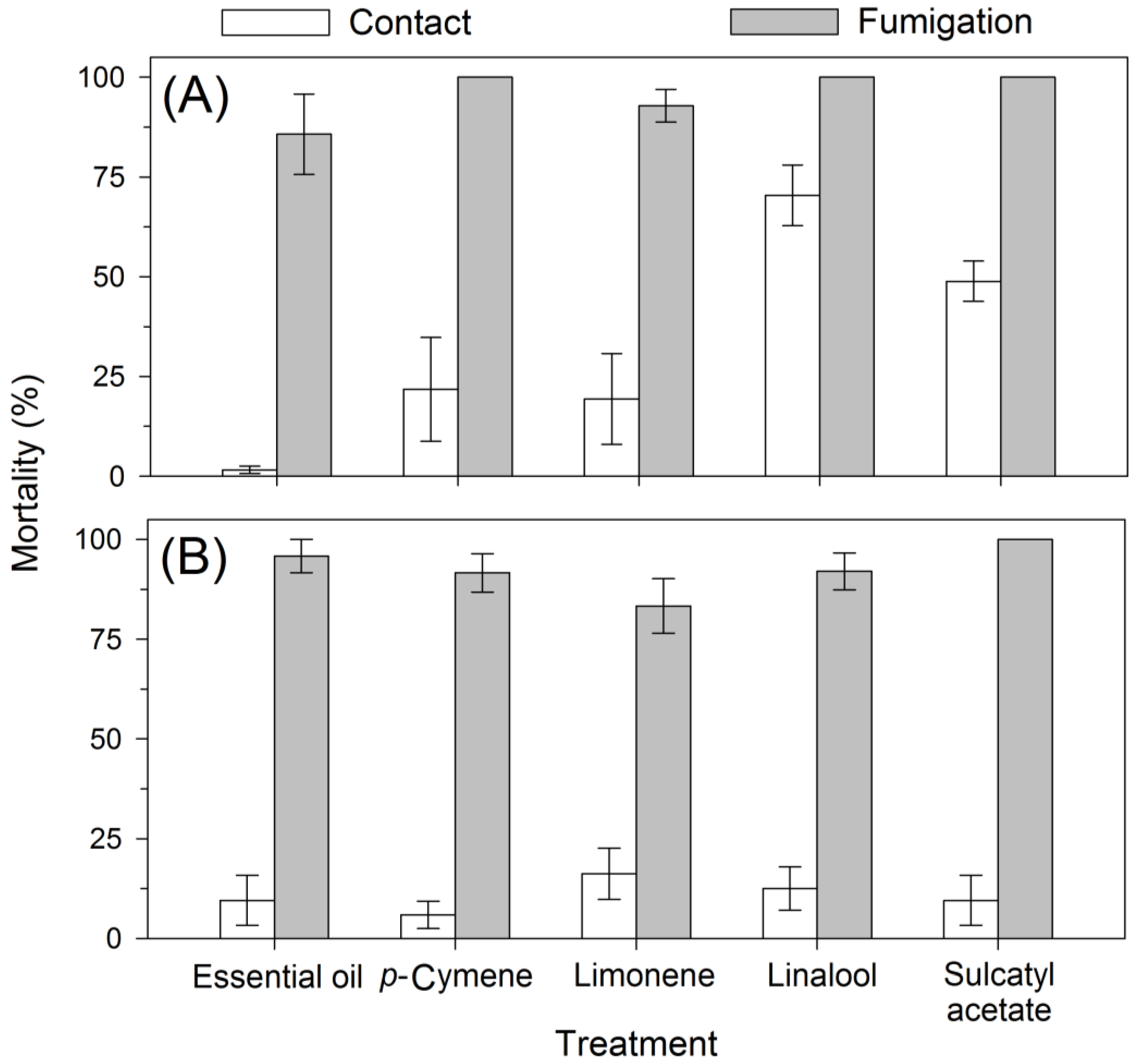
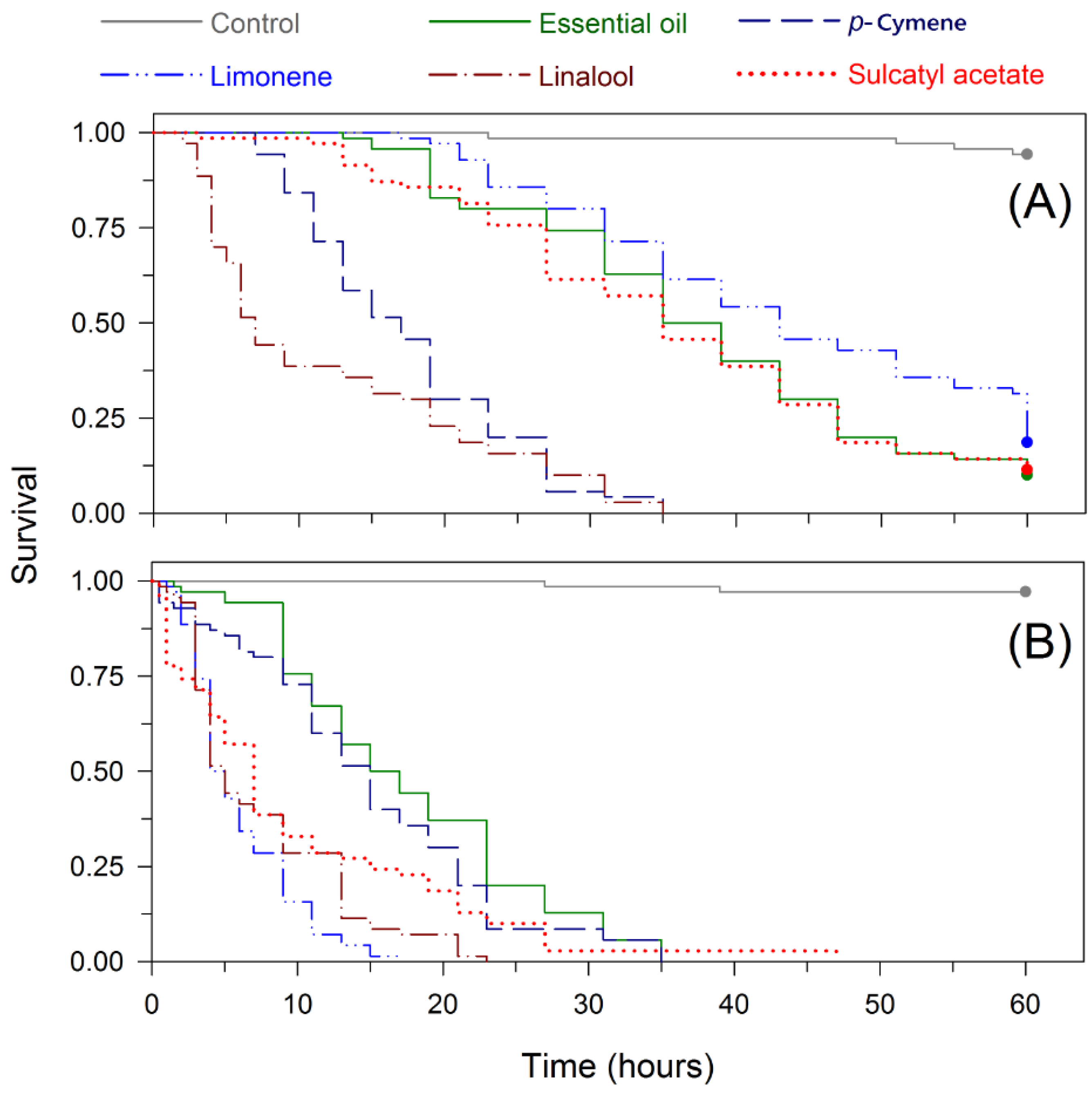
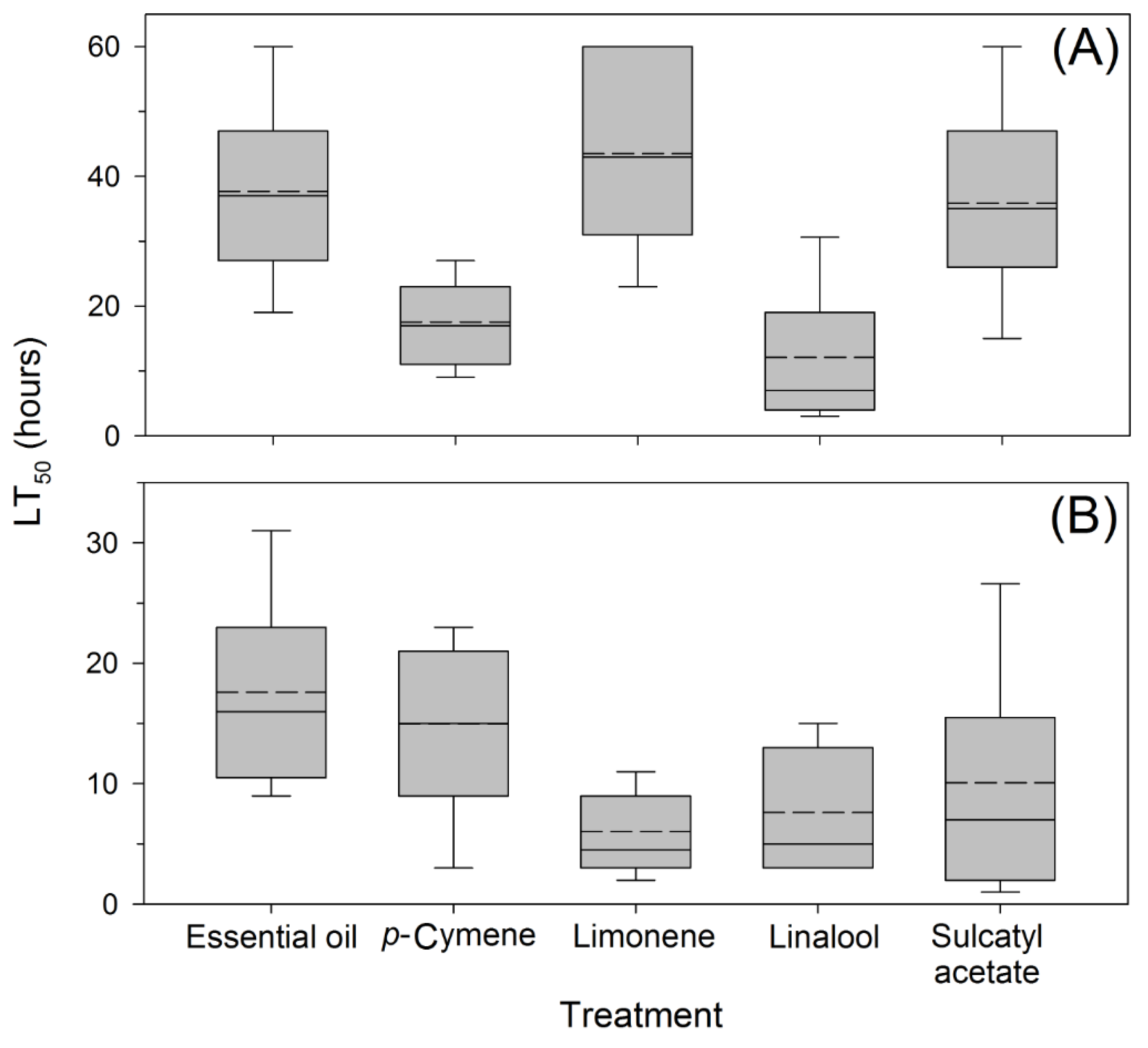
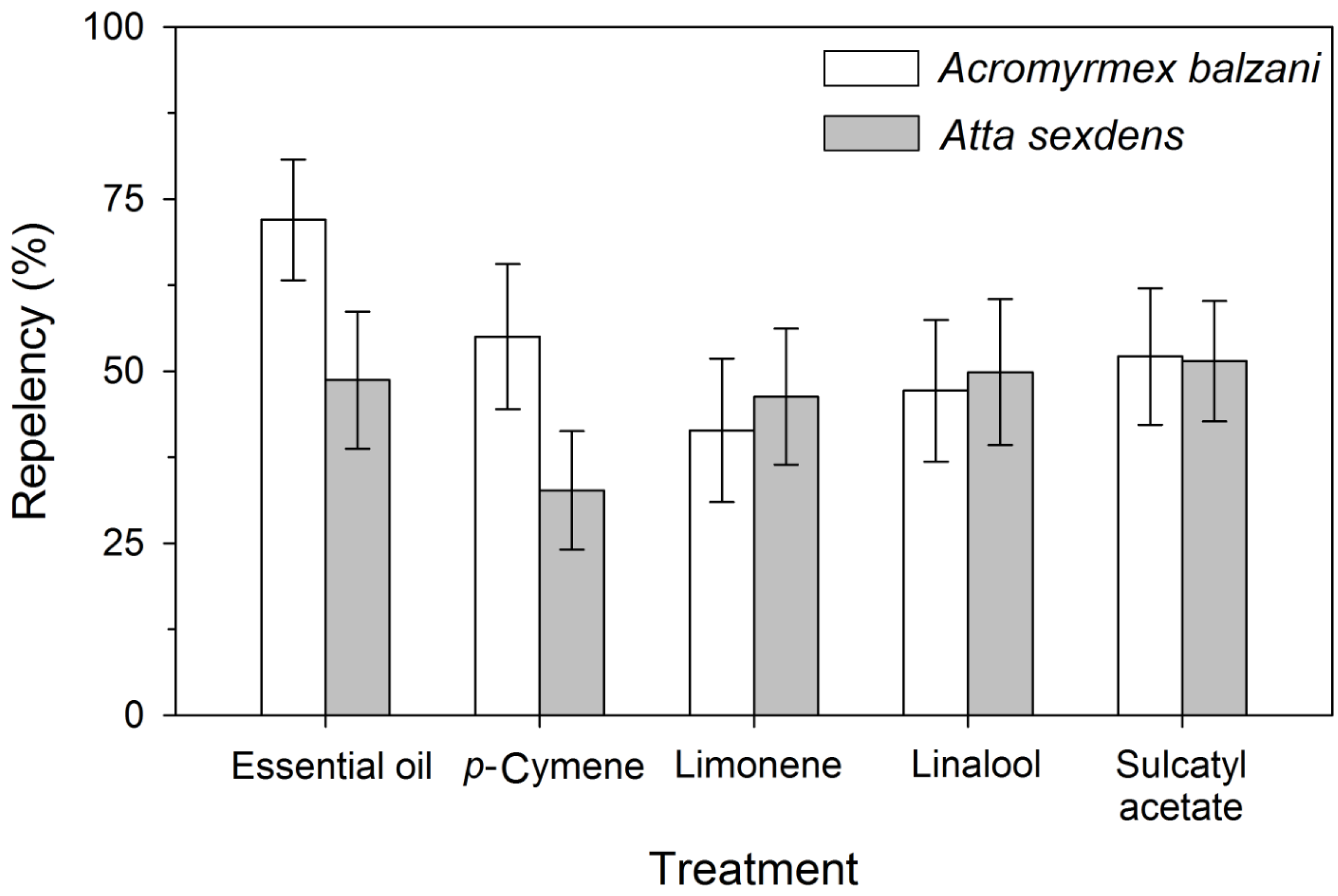
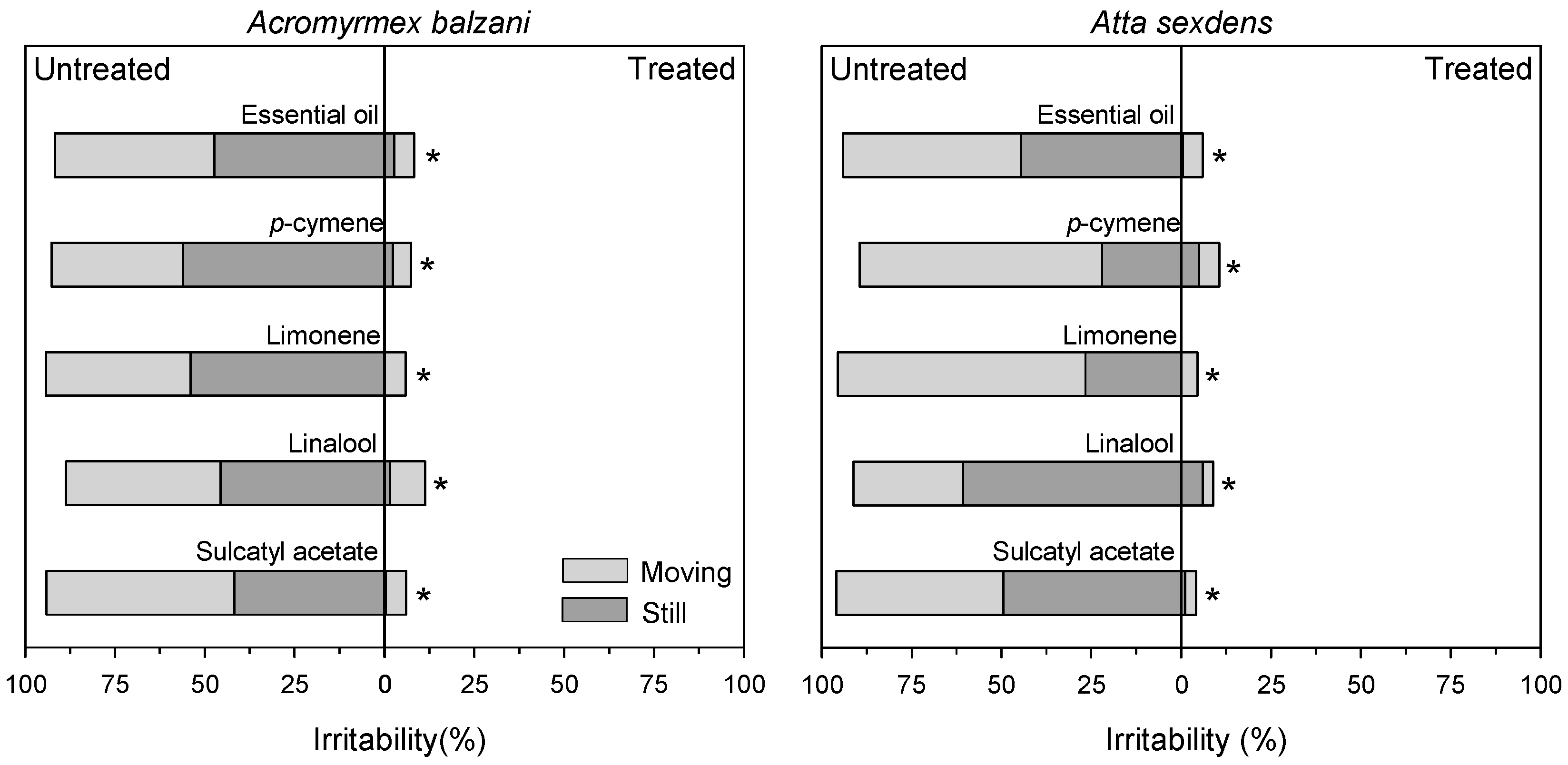

| Component | Retention Time (min) 1 | Retention Index 1 | Peak Area (%) 2 |
|---|---|---|---|
| Tricyclene | 8.985 | 929 | 1.88 ± 0.02 |
| Camphene | 9.469 | 944 | 3.24 ± 0.012 |
| β-Pinene | 10.353 | 973 | 1.05 ± 0.02 |
| Myrcene | 10.681 | 984 | 0.68 ± 0.03 |
| 6-Methyl-5-hepten-2-ol | 10.728 | 985 | 0.64 ± 0.08 |
| p-Cymene | 11.859 | 1020 | 10.41 ± 0.03 |
| Limonene | 12.021 | 1025 | 24.80 ± 0.26 |
| (Z)-β-Ocimene | 12.546 | 1041 | 5.27 ± 0.42 |
| Linalool | 14.257 | 1092 | 9.51 ± 0.05 |
| Sulcatyl acetate | 15.220 | 1122 | 25.64 ± 0.45 |
| Borneol | 16.568 | 1165 | 0.64 ± 0.05 |
| α-Terpineol | 17.328 | 1189 | 0.28 ± 0.02 |
| Bornyl acetate | 20.222 | 1283 | 0.79 ± 0.007 |
| β-Elemene | 23.345 | 1391 | 0.30 ± 0.012 |
| (E)-Caryophyllene | 24.260 | 1424 | 1.15 ± 0.03 |
| Aromadendrene | 24.633 | 1438 | 0.27 ± 0.01 |
| Allo-Aromadendrene | 25.415 | 1467 | 0.27 ± 0.0 |
| Germacrene D | 25.922 | 1485 | 0.70 ± 0.007 |
| Bicyclogermacrene | 26.343 | 1501 | 1.52 ± 0.02 |
| δ-Cadinene | 26.933 | 1524 | 0.40 ± 0.06 |
| Spathulenol | 28.508 | 1586 | 3.04 ± 0.10 |
| Globulol | 28.695 | 1594 | 4.29 ± 0.13 |
| Viridiflorol | 28.903 | 1602 | 0.49 ± 0.03 |
| Isospathulenol | 29.971 | 1646 | 0.94 ± 0.05 |
| α-Cadinol | 30.348 | 1662 | 0.55 ± 0.05 |
| Monoterpenes (%) | 84.83 | ||
| Sesquiterpenes (%) | 13.89 | ||
| Total (%) | 98.72 |
| Treatment | N° of Insects | LC50 (95% CI) (µL·L−1) | LC90 (95% CI) (µL·L−1) | Slope | χ2 | p-Value |
|---|---|---|---|---|---|---|
| Acromyrmex balzani | ||||||
| Essential oil | 239 | 3.76 (3.46–4.13) | 9.33 (7.65–12.68) | 3.24 | 0.15 | 0.98 |
| p-Cymene | 490 | 4.96 (4.41–5.56) | 16.53 (13.08–22.83) | 2.44 | 13.73 | 0.05 |
| Limonene | 546 | 5.72 (5.32– 6.14) | 10.34 (9.39–11.68) | 4.98 | 0.61 | 0.74 |
| Linalool | 238 | 2.40 (1.92–3.21) | 17.51 (10.35–40.99) | 1.48 | 3.55 | 0.81 |
| Sulcatyl acetate | 266 | 2.18 (2.06–2.30) | 3.38 (3.11–3.76) | 6.75 | 1.67 | 0.56 |
| Atta sexdens | ||||||
| Essential oil | 476 | 5.48 (4.66–6.34) | 20.94 (16.78–28.33) | 2.20 | 0.24 | 0.88 |
| p-Cymene | 420 | 3.37 (2.69–4.04) | 17.71 (13.38–26.86) | 1.77 | 0.36 | 0.83 |
| Limonene | 420 | 5.38 (4.56–6.28) | 28.79 (21.33–44.74) | 1.75 | 5.18 | 0.15 |
| Linalool | 308 | 5.34 (4.67–6.28) | 19.88 (14.24–34.61) | 2.24 | 1.72 | 0.57 |
| Sulcatyl acetate | 330 | 6.73 (5.41–10.40) | 20.75 (12.56–60.72) | 2.61 | 1.94 | 0.61 |
| Component A | Component B | Conc. 1 (µL·L−1) | Mortality (%) | χ2 | Effect | |||
|---|---|---|---|---|---|---|---|---|
| Pure Component | Binary Mixture | |||||||
| Observed A | Observed B | Expected | Observed | |||||
| Acromyrmex balzani | ||||||||
| Sulcatyl acetate | Linalool | 2.30 + 2.30 | 21.43 | 19.64 | 36.86 | 67.86 | 26.06 | Synergistic |
| Sulcatyl acetate | Linalool | 2.06 + 2.06 | 7.14 | 10.71 | 17.09 | 39.29 | 28.82 | Synergistic |
| Sulcatyl acetate | p-Cymene | 2.30 + 2.30 | 21.43 | 25.00 | 41.07 | 62.50 | 11.18 | Synergistic |
| Sulcatyl acetate | p-Cymene | 2.06 + 2.06 | 7.14 | 5.36 | 12.12 | 23.21 | 10.16 | Synergistic |
| Sulcatyl acetate | Limonene | 2.30 + 2.30 | 21.43 | 3.57 | 24.23 | 46.43 | 20.32 | Synergistic |
| Sulcatyl acetate | Limonene | 2.06 + 2.06 | 7.14 | 3.57 | 10.46 | 32.14 | 44.95 | Synergistic |
| Linalool | p-Cymene | 3.21 + 3.21 | 16.07 | 23.21 | 35.55 | 67.86 | 29.35 | Synergistic |
| Linalool | p-Cymene | 1.92 + 1.92 | 10.71 | 3.57 | 13.90 | 30.36 | 19.47 | Synergistic |
| Linalool | Limonene | 3.21 + 3.21 | 16.07 | 5.36 | 20.57 | 66.07 | 100.67 | Synergistic |
| Linalool | Limonene | 1.92 + 1.92 | 10.71 | 5.36 | 15.50 | 26.79 | 8.22 | Synergistic |
| p-Cymene | Limonene | 5.56 + 5.56 | 51.79 | 14.29 | 58.67 | 87.50 | 14.16 | Synergistic |
| p-Cymene | Limonene | 4.41 + 4.41 | 44.64 | 17.86 | 54.53 | 82.14 | 13.99 | Synergistic |
| Atta sexdens | ||||||||
| p-Cymene | Linalool | 4.04 + 4.04 | 33.93 | 50.00 | 66.96 | 60.71 | 0.58 | Additive |
| p-Cymene | Linalool | 2.69 + 2.69 | 19.64 | 39.29 | 51.21 | 44.64 | 0.84 | Additive |
| p-Cymene | Limonene | 4.04 + 4.04 | 33.93 | 16.07 | 44.55 | 33.93 | 2.53 | Additive |
| p-Cymene | Limonene | 2.69 + 2.69 | 19.64 | 8.93 | 26.82 | 19.64 | 1.92 | Additive |
| p-Cymene | Sulcatyl acetate | 4.04 + 4.04 | 33.93 | 67.86 | 78.76 | 92.86 | 2.52 | Additive |
| p-Cymene | Sulcatyl acetate | 2.69 + 2.69 | 19.64 | 17.86 | 33.99 | 44.64 | 3.34 | Additive |
| Linalool | Limonene | 6.28 + 6.28 | 55.36 | 50.00 | 77.68 | 87.50 | 1.24 | Additive |
| Linalool | Limonene | 4.67 + 4.67 | 42.86 | 23.21 | 56.12 | 60.71 | 0.38 | Additive |
| Linalool | Sulcatyl acetate | 6.28 + 6.28 | 55.36 | 75.00 | 88.84 | 98.21 | 0.99 | Additive |
| Linalool | Sulcatyl acetate | 4.67 + 4.67 | 42.86 | 35.71 | 63.27 | 75.00 | 2.18 | Additive |
| Limonene | Sulcatyl acetate | 6.28 + 6.28 | 39.29 | 82.14 | 89.16 | 91.07 | 0.04 | Additive |
| Limonene | Sulcatyl acetate | 4.56 + 4.56 | 26.79 | 48.21 | 62.09 | 76.79 | 3.48 | Additive |
© 2017 by the authors. Licensee MDPI, Basel, Switzerland. This article is an open access article distributed under the terms and conditions of the Creative Commons Attribution (CC BY) license ( http://creativecommons.org/licenses/by/4.0/).
Share and Cite
De Oliveira, B.M.S.; Melo, C.R.; Alves, P.B.; Santos, A.A.; Santos, A.C. C.; Santana, A.D. S.; Araújo, A.P.A.; Nascimento, P.E.S.; Blank, A.F.; Bacci, L. Essential Oil of Aristolochia trilobata: Synthesis, Routes of Exposure, Acute Toxicity, Binary Mixtures and Behavioral Effects on Leaf-Cutting Ants. Molecules 2017, 22, 335. https://doi.org/10.3390/molecules22030335
De Oliveira BMS, Melo CR, Alves PB, Santos AA, Santos ACC, Santana ADS, Araújo APA, Nascimento PES, Blank AF, Bacci L. Essential Oil of Aristolochia trilobata: Synthesis, Routes of Exposure, Acute Toxicity, Binary Mixtures and Behavioral Effects on Leaf-Cutting Ants. Molecules. 2017; 22(3):335. https://doi.org/10.3390/molecules22030335
Chicago/Turabian StyleDe Oliveira, Bruna Maria S., Carlisson R. Melo, Péricles B. Alves, Abraão A. Santos, Ane Caroline C. Santos, Alisson Da S. Santana, Ana Paula A. Araújo, Pedro E. S. Nascimento, Arie F. Blank, and Leandro Bacci. 2017. "Essential Oil of Aristolochia trilobata: Synthesis, Routes of Exposure, Acute Toxicity, Binary Mixtures and Behavioral Effects on Leaf-Cutting Ants" Molecules 22, no. 3: 335. https://doi.org/10.3390/molecules22030335






